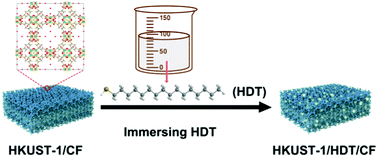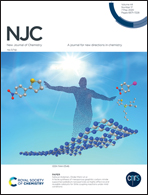Fabrication of a superhydrophobic surface using a simple in situ growth method of HKUST-1/copper foam with hexadecanethiol modification
Abstract
A superhydrophobic copper foam (CF) with excellent robustness and durability was successfully fabricated by using an in situ growth method combined with surface hexadecanethiol (HDT) modification of HKUST-1/CF. The wettability mechanism for the conversion of the superhydrophilic to superhydrophobic states was clarified and explored via density functional theory (DFT). The as-prepared HKUST-1/HDT/CF surface possessed good superhydrophobicity under the optimal conditions including the mass ratio of copper nitrate trihydrate (Cu(NO3)2·3H2O) to 1,3,5-benzenetricarboxylicacid (H3BTC), HDT immersion time, in situ growth time and hydrothermal reaction temperature. The superhydrophobic surface can maintain a desirable hydrophobic state after immersing in different pH solutions, abrasion of weight, and continuous ultrasonic testing. The highest water contact angle (WCA) value of the obtained samples was 162.9° under the aforementioned harsh conditions. Additionally, the superhydrophobic CF has a bright future in the field of oil/water separation due to the obtained HKUST-1/HDT/CF surface with excellent water-repellent performance.



 Please wait while we load your content...
Please wait while we load your content...